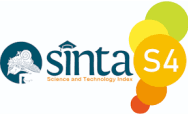Online Submissions
Already have a Username/Password for BELAJAR BAHASA: Jurnal Ilmiah Program Studi Pendidikan Bahasa dan Sastra Indonesia?
Go to Login
Author Guidelines
- Articles are written between 4000-5000 words containing the importance of the topic, the gap between theory and practice or between reality and expectation, or lacks of studies, objectives of the present study, method, findings, conclusion, and acknowledgment if needed.
- Articles should be written in single space, using Microsoft Word, font size 10, Calibri, top and left margin 3 cm, bottom and right margin 3 cm, page size A4.
- The title should be written in Calibri bold, uppercase, 12 pt, and centered alignment, and spaced 1.15.
- The author's name is written using Calibri 11 pt, centered and without using a title and includes the affiliation, study program, faculty, university, and email address.
- On the abstract, explicitly write in bold: Introduction, the objective of the papers, method, findings, and conclusion.
- Abstract contents are written with a single column, Calibri font (9 pt, Italic), 1.0 space, and Indent of page layout for left and right is 1,25 cm.
- Keywords need to be included to describe the domain of the problem under study and the main terms that underlie the implementation of the research, separated by commas and use Calibri font (9 pt, italic, and bold).
- The main content of article should type in two columns, with a distance between columns is 1 cm. except for tables and figures can use 1 column (Calibri 10 pt, Space 1,15, 0 pt)
- Subtitles use Calibri, size 10 pt, bold, and space is 1.15.
- The introduction must include the background to the research, the significance of the research, and the issues raised in the research.
- The method of the research following the general guidelines for the methodology of quantitative research, qualitative research, and mixed methods.
- The method describes the design of activities, space scope or objects, materials, and means of primary research, place, population, sample, informants, engineering data collection, the definition of operations, and variable of research
- Discussion of your research results is a must and really important to your manuscript
- The discussion section presents the results of data processing, interprets the findings logically, associates with relevant and up-to-date reference sources.
- The writing rules of reference in this article follow the system of the American Psychological Association (APA) Style. With format (author name_comma_year_comma_page number). Example: (Riemer, 2010, p. 46).
- Tables should be placed at the top or bottom of a page may be presented in one column wherever possible and may be presented in one column.
- The font size for the table is a maximum of 10 pt without bold.
- All tables should be numbered with Arabic numerals. Every table should have a caption
- Figures should be placed at the top or bottom of a page wherever possible, as close as possible to the first reference to the figures in the paper.
- All figures should be numbered with Arabic numerals. Every figure should have a caption. All photographs, schemas, graphs, and diagrams are to be referred to as figures.
- Conclusions present a summary of the description of the results and discussion, referring to the research objectives.
- All citations originating from books and journals must be included in the reference list. The provisions for the number of referral lists in this Language Learning journal are a minimum of 15 references and prioritized from the latest articles from scientific journals
- The author can write acknowledgment when necessary. Please make the acknowledgment as concise as possible.
- The following references refer to the APA citation style and can be used as an example. Please pay attention on how to cite books, journal articles, thesis/dissertation, and other sources.
Amilia, F. (2014). Definisi dalam Kamus Besar Bahasa Indonesia. Surabaya: Universitas Negeri Surabaya (Unpublished Thesis)
Fraser, B., & Nolen, W. (1981). The association of deference with linguistic form. lnternational Journal of Sociology of Language, 17, 93-109.
Kasper, G. (1990). Linguistic politeness: Current research issues. Journal of Pragmatics, 14, 193-218.
Kuntarto, E. (1996). Strategi Kesantunan Dwibahasawan Indonesia-Jawa: Kajian Wacana Lisan Bahasa Indonesia. IKIP Malang Dissertation, Unpublished. Retrieved from https://scholar.google.com/scholar?oi= bibs&hl=en&scilib=1
Lembaga Ilmu Pengetahuan Indonesia. (2012). Pedoman Karya Tulis Ilmiah. Online. http://pusbindiklat.lipi.go.id/wp-content/uploads/Peraturan-Kepala-LIPI-ttg-Pedoman-KTI.pdf.
Riduan, A. (2014). Penulisan Sumber Kutipan Dan Daftar Pustaka (Tugas Akhir, Skripsi, Tesis, Disertasi, dan Artikel Jurnal) Sekolah Tinggi Ilmu Ekonomi Indonesia (Stiesia) Surabaya. Retrieved Juni 12, 2018, from http://siat.ung.ac.id/files/wisuda/2014-2-1-84205-431409014-ab
Winardi, G. (2002). Panduan Mempersiapkan Tulisan Ilmiah. Bandung: Akatiga.
Copyright Notice
Authors retain copyright and grant the journal right of first publication with the work simultaneously licensed under a Creative Commons Attribution 4.0 International License that allows others to share the work with an acknowledgement of the work's authorship and initial publication in this journal.
This work is licensed under a Creative Commons Attribution 4.0 International License.
Address:Jl. Karimata No. 49 Jember-Jawa Timur-Indonesia
Phone & Fax:(0331)336728 | 337957
Email:belajarbahasa@unmuhjember.ac.id










